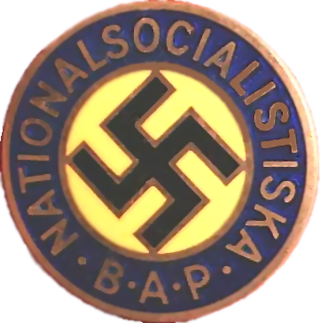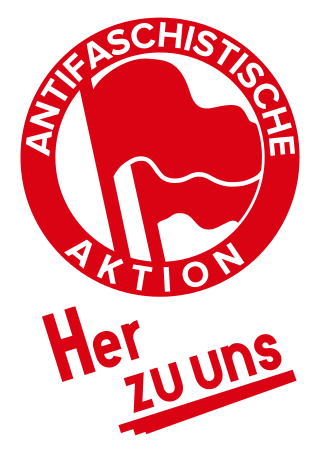
The Nazi Party, officially the National Socialist German Workers' Party, was a far-right political party in Germany active between 1920 and 1945 that created and supported the ideology of Nazism. Its precursor, the German Workers' Party, existed from 1919 to 1920. The Nazi Party emerged from the extremist German nationalist, racist and populist Freikorps paramilitary culture, which fought against the communist uprisings in post–World War I Germany. The party was created to draw workers away from communism and into völkisch nationalism. Initially, Nazi political strategy focused on anti–big business, anti-bourgeois, and anti-capitalist rhetoric, which was later downplayed to gain the support of business leaders. By the 1930s, the party's main focus shifted to antisemitic and anti-Marxist themes. The party had little popular support until the Great Depression, where worsening living standards and vast unemployment drove Germans into political extremism.

Der Stahlhelm, Bund der Frontsoldaten, commonly known as Der Stahlhelm, was a German First World War veteran's organisation existing from 1918 to 1935. It was part of the "Black Reichswehr" and in the late days of the Weimar Republic operated as the paramilitary wing of the monarchist German National People's Party (DNVP), placed at party gatherings in the position of armed security guards.
National Socialist Party most often refers to the National Socialist German Workers' Party, commonly known as the Nazi Party, which existed in Germany between 1920 and 1945 and ruled the country from 1933 to 1945. However, similar names have also been used by a number of other political parties around the world, with various ideologies, some related and some unrelated to the NSDAP.

The Biographical Dictionary of the Extreme Right Since 1890 is a reference book by Philip Rees, on leading people in the various far right movements since 1890. It contains entries for what the author regards as "the 500 major figures on the radical right, extreme right, and revolutionary right from 1890 to the present" . It was published, as a 418-page hardcover, in New York by Simon & Schuster in 1990 (ISBN 0-13-089301-3).

The Socialist Party, was a political party in Sweden active from 1929 to 1948. Led by Karl Kilbom and Nils Flyg, the party was founded in 1929 as a splinter group of the Communist Party of Sweden. Until 1934, the splinter group used the same name Communist Party of Sweden, so in order to keep the two factions apart, this faction was generally known as Kilbommare ("Kilbomiars") while those who stayed in the old party were known as Sillénare.

The Swedish National Socialist Farmers' and Workers' Party was the first Nazi organization in Sweden.

Nationalsocialistiska Arbetarepartiet was a Swedish political party that initially espoused Nazism before adopting a more indigenous form of fascism. It was also widely infamous under the name Svensk socialistisk samling, which was generally among the public called "Lindholmarna".
The National Youth League of Sweden was the first youth organisation of the General Electoral Union of Sweden. It was dislodged from its mother party in 1934 due to its pro-Nazi stance. It was then reconstructed as a separate political party, the National League of Sweden. After the Second World War, the political fortunes of the group dwindled.
Sven Olov Knutsson Lindholm was a Swedish Nazi leader, active in far right politics from the 1920s to the 1950s. This included leading the Nazi party named Svensk socialistisk samling ; despite its name, this party was widely regarded as propagating a fascist/Nazi ideology.

Antifaschistische Aktion was a militant anti-fascist organisation in the Weimar Republic started by members of the Communist Party of Germany (KPD) that existed from 1932 to 1933. It was primarily active as a KPD campaign during the July 1932 German federal election and the November 1932 German federal election and was described by the KPD as a "red united front under the leadership of the only anti-fascist party, the KPD."
Per Claes Sven Edvard Engdahl was a leading Swedish far-right politician. He was a leader of Sveriges Fascistiska Kamporganisation, during the 1930s.
Elof Eriksson (1883–1965) was a Swedish antisemitic political writer. He was recognised as the main exponent of antisemitism in inter-war Sweden along with Einar Åberg.
Nazism in Sweden has been more or less fragmented and unable to form a mass movement since its beginning in the early 1920s. Several hundred parties, groups, and associations existed from the movement's founding through the present. At most, purely Nazi parties in Sweden have collected around 27,000 votes in democratic parliamentary elections. The high point came in the municipal elections of 1934 when the Nazi parties were victorious in over one hundred electoral contests. As early as January 22, 1932, the Swedish Nazis had their first public meeting with Birger Furugård addressing an audience of 6000 at the Haymarket in Stockholm.

The Swedish National Socialist Party was a Nazi political party in Sweden. Birger Furugård served as riksledare of the party.

Konrad Otto Kristian Hallgren was a Swedish party chairman in Sweden's first fascist organization, Sveriges Fascistiska Kamporganisation.
Munckska kåren was a Swedish secret paramilitary group founded by the retired lieutenant general Bror Munck in 1927. While nominally apolitical, it was founded to protect the Swedish state against "domestic enemies", implying not fascists or nazis, but solely left-wing radicals. At its height it had about 2,000 members.
Hilding Gustaf Sigvard Ekström was a Swedish chemist, Waffen-SS volunteer, and co-founder of the Sweden Democrats party.
The National Socialist Union of Finland, later the Finnish-Socialist Party was a Finnish Nazi political party active in the 1930s, whose driving force and ideologue was Professor Yrjö Ruutu. With an ideology based on Ruutu's theories, the party came to reject orthodox German Nazism.








